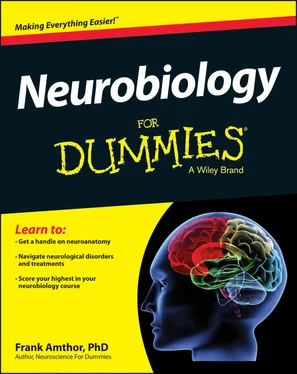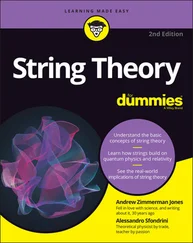1 ...8 9 10 12 13 14 ...23 The genetic code is a sequence of three nucleotides (called a codon ) that specifies an amino acid. As I mention earlier in this chapter, four types of nucleotides exist, so a three-nucleotide sequence (such as ACT or TAG) with four choices at each position allows for 64 possible codons (or 4 3). However, only 20 amino acids are used to make proteins. Several different codons specify the same amino acid. This may sound redundant, and the concept is sometimes called degeneracy, but this degeneracy does have benefits. One benefit is that some mutations that change one of the nucleotides may not change which amino acid is produced — so the protein’s function won’t be compromised.
 Messenger RNA has a “start” codon that codes for methionine in eukaryotes. Three special codons (TAA, TGA, and TAG), called “stop” codons, signify the end of the coding region for one protein. Start and stop codons allow the biochemical machinery that generates proteins from DNA to begin and end on the right nucleotides. A frame shift error occurs when translation doesn’t start at the beginning of a codon, but reads the end of one codon and the beginning of another. A frame shift error causes the entire sequence of amino acids to be wrong.
Messenger RNA has a “start” codon that codes for methionine in eukaryotes. Three special codons (TAA, TGA, and TAG), called “stop” codons, signify the end of the coding region for one protein. Start and stop codons allow the biochemical machinery that generates proteins from DNA to begin and end on the right nucleotides. A frame shift error occurs when translation doesn’t start at the beginning of a codon, but reads the end of one codon and the beginning of another. A frame shift error causes the entire sequence of amino acids to be wrong.
Transcription occurs in the cell nucleus. The transcription process “reads” the DNA code to create a matching messenger RNA molecular template that will exit the nucleus and be used to synthesize proteins. The RNA strand is complementary to the DNA strand, just like the two single DNA strands are complementary to each other in the double helix, except that in RNA the nucleotide uracil takes the place that thymine occupies in DNA.
In transcription, one strand of the DNA double helix — the template strand — is used to form the complementary mRNA sequence. The transcription process has three stages that are regulated by transcription factors and co-activators:
Initiation: In this first part of transcription, DNA is partially “unzipped” by the enzyme helicase, allowing access to the DNA nucleotide sequence for copying. Transcription factors bind the promoter region of the gene, which is a control region immediately preceding the beginning of the gene. Polymerase, the molecule that copies DNA into RNA, binds to a complex of transcription factors at the promoter.
Elongation: RNA polymerase unwinds the DNA double helix, moves down it, and elongates the RNA transcript by adding ribonucleotides in a 5' to 3' direction (refer to the earlier section, “ DNA replication”). The RNA polymerase “reads” the DNA strand sequentially and produces a single strand of messenger RNA (complementary to the DNA sequence that is its template).
Termination: When the RNA polymerase reaches the end of the gene, the mRNA and polymerase detach from the DNA. The single strand of newly synthesized mRNA leaves the nucleus through nuclear pores and migrates into the cytoplasm.
The mRNA sequence is not usually directly translated into the amino acid sequence forming a protein. In eukaryotic cells, the mRNA (called primary transcript ) undergoes post-transcriptional modification to yield what’s called heterophilic nuclear RNA (hnRNA). Spliceosomes (a combination of nucleoproteins and RNA molecules that help to splice) then remove the introns (noncoding parts of the gene) from the hnRNA. This produces the final mRNA — composed of the coding exons. (See the section “ Introns versus exons,” later in this chapter.)
 Ribosomes translate the modified messenger RNA and convert its RNA sequence using transfer RNA (tRNA) on ribosomes. Each transfer RNA is a small RNA molecule that is loosely linked to a single amino acid for which it codes. The ribosome binds to the end of an mRNA molecule and then moves along it. As it moves, it sequentially binds to an appropriate tRNA molecule by base-pairing complementary regions of the tRNA with the codon located on the mRNA. The attached amino acid is added to the forming protein, and the tRNA — no longer carrying amino acids — is released. The process then continues to the next mRNA codon.
Ribosomes translate the modified messenger RNA and convert its RNA sequence using transfer RNA (tRNA) on ribosomes. Each transfer RNA is a small RNA molecule that is loosely linked to a single amino acid for which it codes. The ribosome binds to the end of an mRNA molecule and then moves along it. As it moves, it sequentially binds to an appropriate tRNA molecule by base-pairing complementary regions of the tRNA with the codon located on the mRNA. The attached amino acid is added to the forming protein, and the tRNA — no longer carrying amino acids — is released. The process then continues to the next mRNA codon.
Within the chromosomes, chromatin proteins such as histones compact and organize DNA. These compact structures guide the interactions between DNA and other proteins, helping control which parts of the DNA are transcribed.
Cells can modify the rate at which specific gene products (protein or RNA) are produced. This occurs as cells proceed down their developmental pathways, but it also occurs in response to environmental stimuli. Gene expression can be modified at all the stages of transcription, RNA processing, and post-translational protein modification.
One of the main mechanisms of regulating DNA expression is methylation by methyltransferase enzymes (adding methyl groups to adenine or cytosine nucleotides in the DNA), which occurs on cytosine nucleotides. Another important regulation mechanism is histone acetylation, when histone acetyltransferase enzymes (HATs) dissociate the histone complex from a section of DNA. The presence of histones blocks expression, so by removing histones, transcription can proceed. Methylation and histone deacetylation may act simultaneously to control DNA expression.
The discovery that many genes were interrupted by introns (intervening sequences) that were not expressed came as quite a shock to much of the scientific world. Depending on the species, introns may be the majority of the total DNA sequence of the organism. RNA splicing (refer to the earlier section “ Protein synthesis”) removes introns to produce a final mRNA molecule ready for translation. The term intron refers to both the non-expressed DNA sequence and its corresponding sequence in the unspliced mRNA. After the introns are spliced out of the mRNA, the result is called an exon.
 The origin of introns is still unclear. Introns were initially viewed as accidental DNA sequences, possibly leftovers from evolution or even parasitic “selfish” DNA. One conjecture has been that introns provide places for the DNA sequence to break during crossover in meiosis, making it less likely that a break will occur in the middle of a needed gene.
The origin of introns is still unclear. Introns were initially viewed as accidental DNA sequences, possibly leftovers from evolution or even parasitic “selfish” DNA. One conjecture has been that introns provide places for the DNA sequence to break during crossover in meiosis, making it less likely that a break will occur in the middle of a needed gene.
Regardless of their origin, introns allow the protein sequences generated from a single gene to vary greatly. This is because the same DNA sequence can generate different proteins by varying how the mRNA is spliced. Environmental factors that get taken up by a cell can modify the control of alternative RNA splicing.
Protein synthesis versus regulation
The classic picture of DNA being transcribed to RNA, and RNA being translated into proteins, was typically thought of as a one-way process. However, this description is not complete. The products of DNA expression, as well as external substances that get taken up by a cell, can also regulate protein production.
One example of the backward flow of information (or backward synthesis ) is reverse transcription, which is the transfer of information from RNA to make new DNA. Reverse transcription occurs in retroviruses such as HIV and is a common feature of the replication cycle for many viruses. The main function of many proteins synthesized from DNA is to regulate DNA expression, typically by modulating methylation and histone acetylation (refer to “Gene regulation,” earlier in this chapter). The expression of DNA can even be regulated by sequences within the DNA itself. For example, some introns enhance the expression of the gene in which they dwell through a process called intron-mediated enhancement . More generally, introns may have short sequences that are important for efficient splicing by spliceosomes.
Читать дальше

 Messenger RNA has a “start” codon that codes for methionine in eukaryotes. Three special codons (TAA, TGA, and TAG), called “stop” codons, signify the end of the coding region for one protein. Start and stop codons allow the biochemical machinery that generates proteins from DNA to begin and end on the right nucleotides. A frame shift error occurs when translation doesn’t start at the beginning of a codon, but reads the end of one codon and the beginning of another. A frame shift error causes the entire sequence of amino acids to be wrong.
Messenger RNA has a “start” codon that codes for methionine in eukaryotes. Three special codons (TAA, TGA, and TAG), called “stop” codons, signify the end of the coding region for one protein. Start and stop codons allow the biochemical machinery that generates proteins from DNA to begin and end on the right nucleotides. A frame shift error occurs when translation doesn’t start at the beginning of a codon, but reads the end of one codon and the beginning of another. A frame shift error causes the entire sequence of amino acids to be wrong. The origin of introns is still unclear. Introns were initially viewed as accidental DNA sequences, possibly leftovers from evolution or even parasitic “selfish” DNA. One conjecture has been that introns provide places for the DNA sequence to break during crossover in meiosis, making it less likely that a break will occur in the middle of a needed gene.
The origin of introns is still unclear. Introns were initially viewed as accidental DNA sequences, possibly leftovers from evolution or even parasitic “selfish” DNA. One conjecture has been that introns provide places for the DNA sequence to break during crossover in meiosis, making it less likely that a break will occur in the middle of a needed gene.










